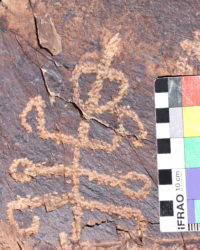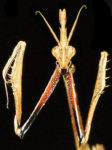 An unusual praying mantis petroglyph has been found at the Teymareh rock art site in central Iran. The carved image 5.5 inches long and 4.3 inches wide was discovered during a 2017-2018 survey by archaeologists. Its precise age is unknown because radiocarbon dating cannot be performed in Iran due to international sanctions, but the rock art at the site ranges in age from 40,000 to 4,000 years old.
An unusual praying mantis petroglyph has been found at the Teymareh rock art site in central Iran. The carved image 5.5 inches long and 4.3 inches wide was discovered during a 2017-2018 survey by archaeologists. Its precise age is unknown because radiocarbon dating cannot be performed in Iran due to international sanctions, but the rock art at the site ranges in age from 40,000 to 4,000 years old.
Rock art imagery can be challenging to decipher, a process the team charmingly describes as “similar to a game of Pictionary, albeit without the artist on hand to say whose guess is correct.” Invertebrates are rarely  depicted in petroglyphs, so the archaeologists collaborated with entomologists to identify the creature from its morphological features. Its six legs, large triangular head with extended vertex, curved hind legs and bent forelimbs marked it as a mantid. Iran’s Empusa genus, which inhabits hot, dry environments like the Teymareh Region, have the expanded vertex seen in the petroglyph.
depicted in petroglyphs, so the archaeologists collaborated with entomologists to identify the creature from its morphological features. Its six legs, large triangular head with extended vertex, curved hind legs and bent forelimbs marked it as a mantid. Iran’s Empusa genus, which inhabits hot, dry environments like the Teymareh Region, have the expanded vertex seen in the petroglyph.
There are two elements that suggest this may not be just a mantis, however. The middle pair of legs have circles at the ends.
The closest parallel to this in archaeology is the ‘Squatter Man,’ a petroglyph figure found around the world depicting a person flanked by circles. While they could represent a person holding circular objects, an alternative hypothesis is that the circles represent auroras caused by atmospheric plasma discharges.
Squatter or Squatting Man figures have been found all over the world, including Arizona, Spain, Italy, Venezuela and the United Arab Emirates. The team believes the Iranian petroglyph is a combination of a praying mantis and a Squatting Man figure, thus they have dubbed him “squatting mantis man.” Sounds like a superhero from Mystery Men.
The study has been published in the Journal of Orthoptera Research. It’s an interesting and entertaining light read. Two enthusiastic forelimbs up.